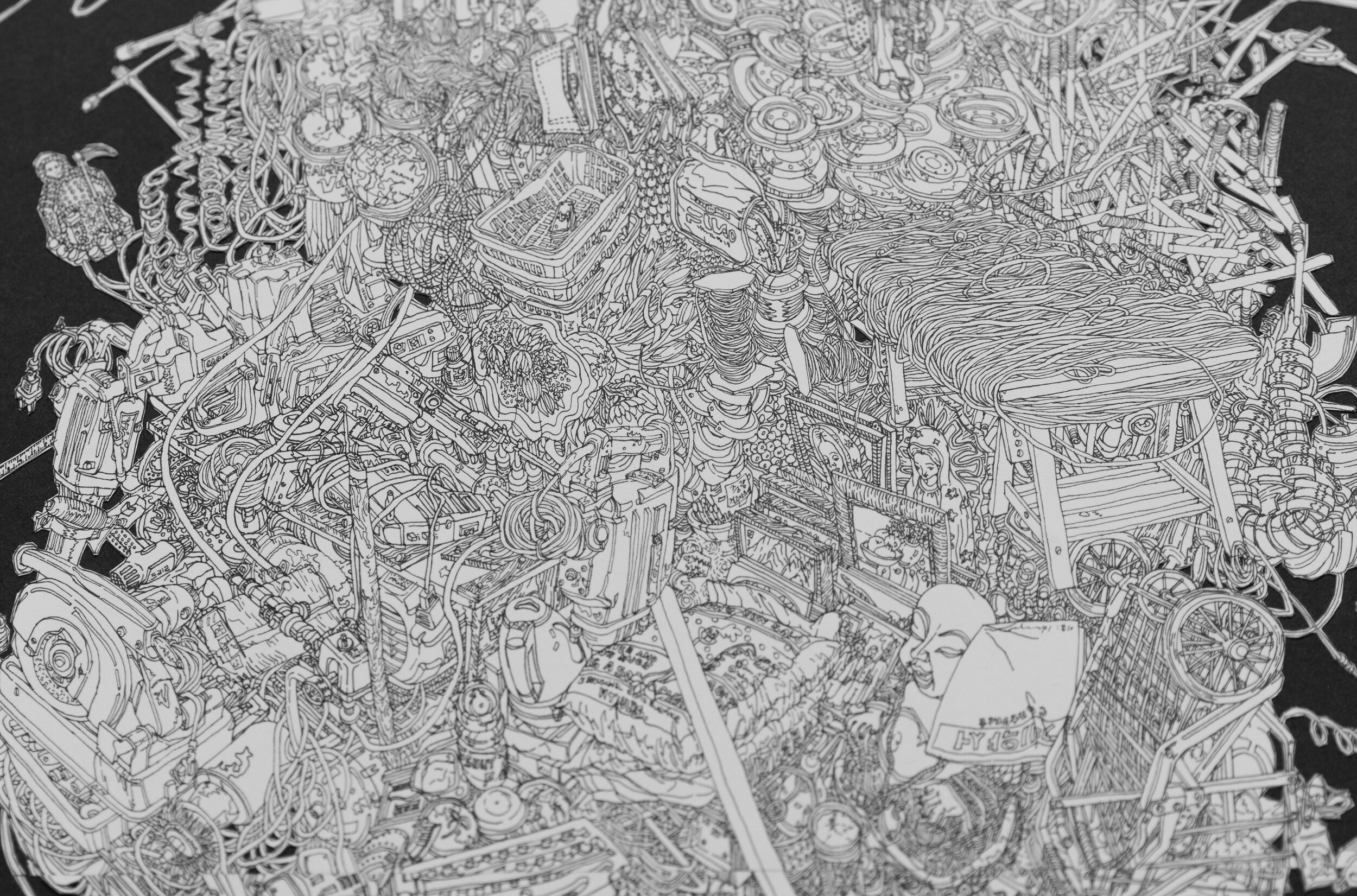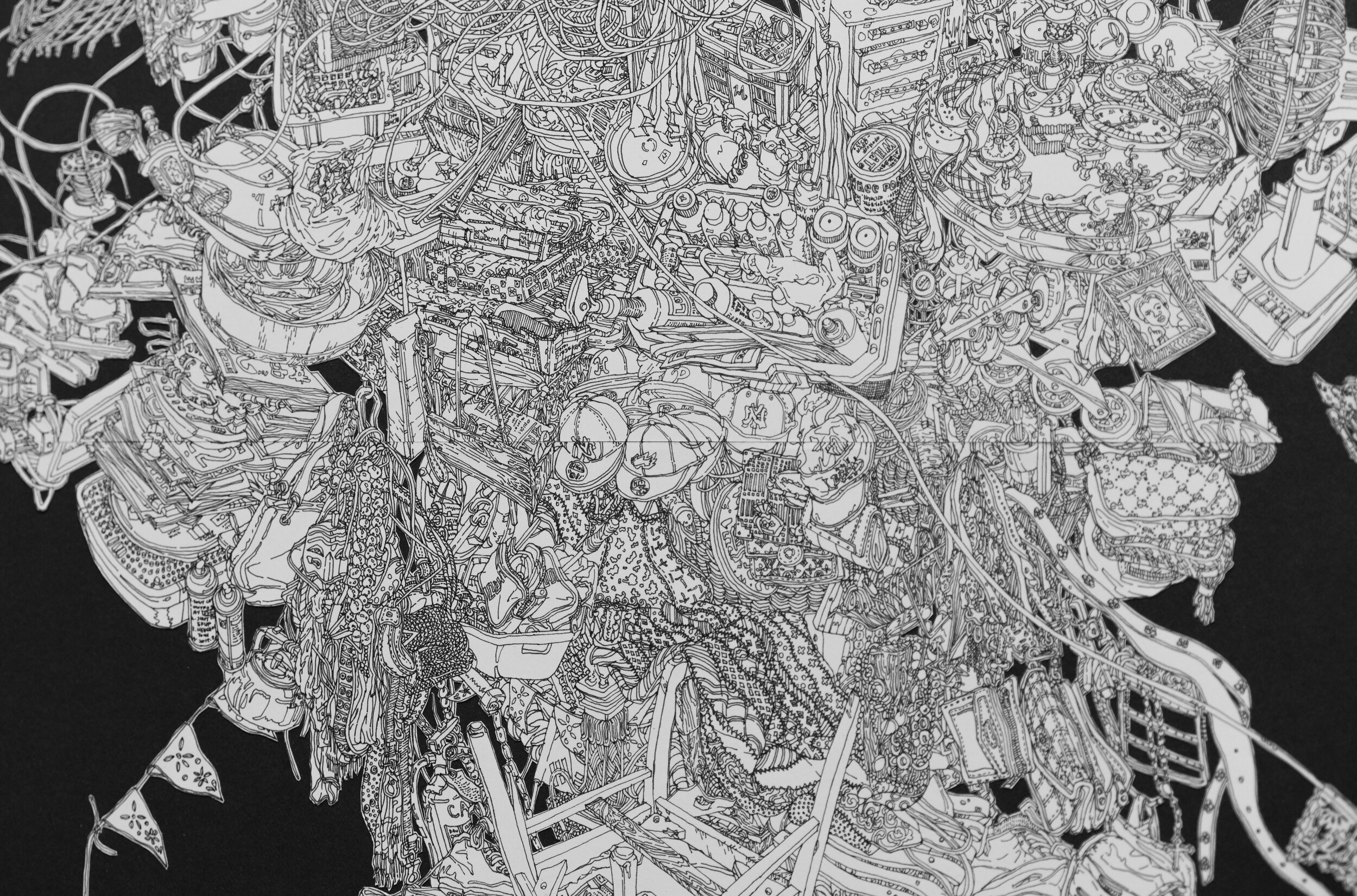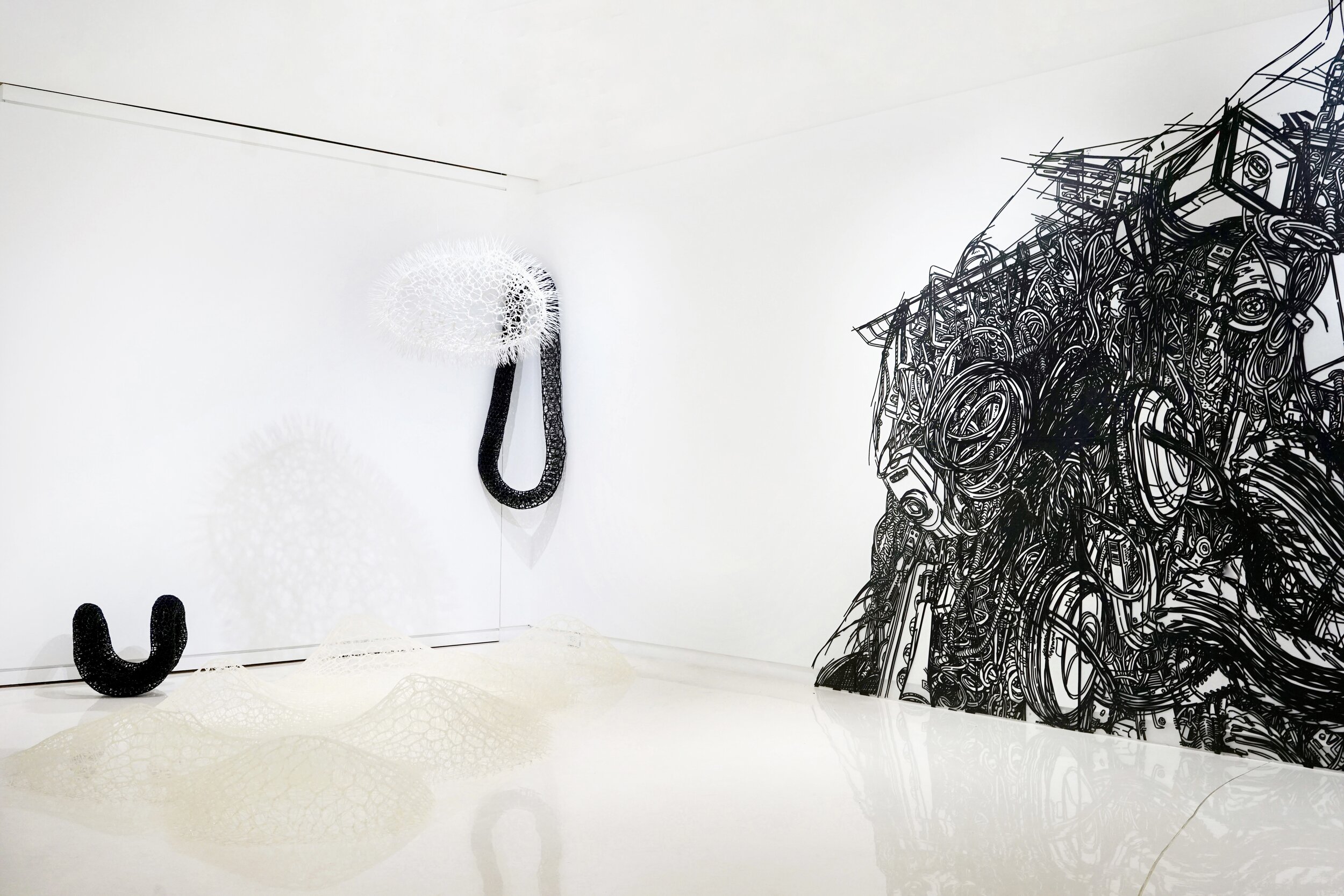Immersion in Black and White:
Heeseop Yoon and Sui Park
Curated by Barbara Stehle, Ph.D.
October 5, 2021 - November 5, 2021
Opening reception on October 5, 6-8pm

















Sapar Contemporary is proud to present a two-person exhibition of Korean American artists Sui Park and Heeseop Yoon curated by Barbara Stehle, Ph.D. Yoon and Park take over the gallery space of Sapar Contemporary with a dialog in black and white. Line is at the center of their pictorial and sculptural works. The installation explores their two worlds, two sides of perception. Their meeting is a contrasted encounter in black and white. The two Korean female artists express themselves in a singular way. Both of them have developed their own technique of creation. Sui Park creates a utopian world with cable ties and monofilament, weaving lines into three dimensions. Heeseop Yoon draws, collages and creates murals with masking tape. Both artists reflect on life and occupation of space with site adaptable works.
Park’s vibrant sculptures and wall works are airy and light. Suspended in the air, on the floor or the wall, they are poetic and alive. They evoke the natural world, not only by their biomorphic shapes, but also their seemingly repetitive molecular like design process. Sui Park’s work meets Heeseop Yoon’s pieces in the architectural environment where both climb up walls and drop to the floor. Heeseop Yoon’s refined drawings are dense and intricate, her murals created with black masking tape spread through space with a worrying ease. Most of Yoon’s creative process involves accumulations and collages. The artist is fascinated by the dystopian world of Urban piles, debris, storages. Both artists have a minimalist line, great sense of construction and impressive spatial presence. Their meeting allows for a cohabitation of Utopia and Dystopia. The threshold between them contracts and expands in a rich dialog.
Heeseop Yoon’s intricate pen drawings, collages and wall installations
Heeseop Yoon’s exquisite black and white drawings are born of a very intense creative process. A minimalist in her private life, the artist is fascinated by spaces of jumble and disorganization. She confesses to having “a formal attraction for piles”. Yoon is hands on. She researches her topic, exploring cities and neighborhoods to photograph massive piles of storage accumulation, rejected things and urban debris. The details she captures will be the starting point of a future project. Yoon draws from this life documentation. She chronicles in her sophisticated drawings the concrete images of the downfalls of our societal consumerism.
Yoon’s work points to the life of things, their accumulation and sad ending. She points to the discarded surpluses of our lives. Her beautiful black and white drawings, finely traced with a sharp inked line in the grand Asian traditions are images of junkyards. The real is more than a topic, it is a preoccupation for her. Heeseop Yoon observes our habits and how they affect and manifest in our environment. The artist says: “Objects have strong metaphorical meanings. I am fascinated by those still life paintings of the past, the Dutch still lives in particular. Now it is not about how precious the objects are. It is about quantity rather than quality. So I foremost want to purely look at the piles.”
Back in the studio, her investigation of the real is taken over by the process of drawing. The artist translates each broken piece, ghostly object, in black and white drawings. The absence of color proceeds to eliminate some of the emotional content. The mass is cleansed, trash transformed into still life. Yoon draws all the details minutely. She will then cut out and paste the pieces she likes on a blank sheet, black or white. She displaces them, accumulates them on this blank space. No outside reference to the still life is left. It transforms our sense of scale. The pile becomes “it”, something fully whole, completely independent from its source, made of many parts that you can explore and wonder about. It is overwhelming and mesmerizing at once.
The pristine background Yoon chooses sets off the collages. The final outline is a result of the cutting and pasting. It happens intuitively. It is not preplanned. The white or black background is a space of presentation as opposed to a space of existence. It erases all contexts and provides a powerful void. The cluster becomes that thing that is portrayed on its own, outside of space. It seems to float in the middle of the page. The effect is a bit surreal. Yoon thinks of it that way: “That space, like a vortex, sucks you. So that the cluster becomes open and you go right into that darkness.” The travel begins.
Yoon notes that in the process of mark making the reality of the piles becomes quite abstract. She is a minimalist by need she says: “It looks like Maximalist works. So adding too much in my style will over do it. I want to stay minimal and simple.” The line is sharp, black, always. It seems straight forward, yet there is a twist to her process: the artist follows a strict additive philosophy. “I draw, I don’t erase a line. I keep adding one. I don’t shift perspective consciously. My point of view changes, the recording of these changes enters the process.” Everything that enters the process is recorded. Lines accumulate until the artist cuts through them.
In Korea, Heeseop Yoon was trained to draw classically, very realistically. When I asked her why she switched to masking tape for her murals she explained: “I can do this from my brain not from my eyes. I can do it from my ideas of that object. So the process of mark making became tedious, as it was for me so easy and fast. I wanted to slow down that process. I tried with pigments, with cutouts. I liked the line quality that tape has. I never cut tape. I use a roll. But the line looks like a gestural drawing, it fills up with speed.”
Heeseop Yoon started working on very large scale in graduate school. Her murals became bigger and bigger each year. Architectural sites are a natural fit for her desire to fill the emptiness with her art. Walls, floors, ceilings, give her a whole new setting. The scale of a junkyard is matched. The works invades the space. The effect is intimidating but also awe-inspiring. Yoon’s technique is so fluid, her ease is striking, her murals and drawings offer the old genre of the still life a new invigorating space, a mirror for our age.
Sui Park’s organic abstract forms
Sui Park’s organic world of abstract forms manifests a poetic space. The artist’s imagination channels the fertile dimension of nature. She reinterprets the world as it is and develops fictional forms. As she does, she ventures into abstraction. Park has the ability to imagine and configure structures of all scales: from the molecular to the territorial. A walk through her soft sculpture installations brings up the same sense of marvel I used to get as a teenager reading Jules Verne’s novels, that feeling of a discovery that raises a reflection on the nature of things, imagination and the creative process.
Sui Park has created a specific language of forms using principally cable ties. She employs a grand variety of ties of: different fabrications, length and colors. They are short links and somewhat prickly. Park connects them and creates netlike surfaces full of textural effects. She bends them as she wills, in small or large volumes, egg shapes or tubular forms. She creates territorial coverage or sculptural forms. The pieces radiate energetically and project strong shadows. As they interact with their environments, indoor or outdoor, they continuously play with the light sources that move through their structure and bounce off their skin.
When Park is not working with cable ties she uses a strong monofilament, basically a fishing line. Contrary to the open net like surface of the cable ties, the monofilament pieces have a perfect opacity. They are tightly woven and form a flexible, pliable whole. Sui Park was trained in the traditional Korean art of basketry. She knows how to weave a line and create volume in the most elegant way. In Park’s hands, monofilaments are turned into glowing three-dimensional shapes. Their surfaces are smooth and shiny: deep and mysterious in black, iridescent in white.
All the pieces can be installed indoors and outdoors. They have an uncanny ability to fit everywhere. Each context reinvents them, and gives them a new reading. Each work is site adaptable and can be placed in various manners. Hanging on trees or a ceiling, up on a wall or a garden side, sitting on the floor or window ledge, on the grass or ground, on the sand or by the water, on a desk or a shelf, the possibilities are endless.
Sui Park’s creations, especially her hairy white formations, often seem alive. Their biomorphic aesthetic makes them cousins to clouds, mushrooms, cacti, seafoam and other natural elements with morphing tendencies. When their hairy spikes are turned in, the pieces appear further enclosed. Their pierced surface all of a sudden is strangely stronger. In black, their density increases, sometimes to the point of having a mineral quality. Their imaginary weight becomes heavier. In reality, the pieces are always so light. But color and textural effects have a phenomenological impact on our perception.
Sui Park uses two common industrial materials in the most unexpected ways. Attentive to details and to the character of her unusual material, she reveals the potential for form making and personal expression in each. Her creative process operates a complete transformation of her medium. One by one, her pieces explore her material further. The artist continuously asks the cable ties and the monofilament: what else can you do? How else can you appear? So she dyes, inverts, leaves some things unfinished, opens and closes the forms, varies the tightness, the framings, expands and contracts. And each time, the new challenge she imposes on herself is matched by her imagination, and she finds new ways and the ties and lines bring new answers.
Heeseop Yoon was born and raised in Seoul, Korea. She holds her BFA from Chung-ang University, Seoul, Korea and MFA from City College of NY, NY. She is known for her large-scaled line drawing installations and also very intricate black and white drawings. She has had solo and two-person shows at Sapar Contemporary, March Gallery, and Bose Pacia, all NY; Arario Gallery, Seoul; University of North Carolina at Chapel Hill; and Monmouth University, West Long Branch, NJ; OZ Art Center, TN. She has exhibited in museums and art centers internationally, including Indianapolis Museum of Contemporary Art, IN; OZ Arts Center, Nashville, TN; Des Moines Art Center, Des Moines, IW; MASS MoCA, North Adams, Massachusetts; John Michael Kohler Arts Center, Sheboygan, Wisconsin; The Bronx Museum, NY; Seoul Arts Center, Korea; China Association for Science and Technology (CAST), Australia and Media Art Center, Beijing, and has participated in several residencies such as the Lower East Side Printshop, Marie Walsh Sharpe Art Foundation; Skowhegan School of Painting, and Artist Alliance Inc., all NY, and Stiftung Künstlerdorf Schöppingen, Germany. She has made her first public mural installation in Italian Market in Philadelphiain 2015. She currently lives and works in Brooklyn, New York.
Sui Park is a New York based artist born in Seoul, Korea. Her work involves creating 3-dimensional flexible organic forms of a comfortable ambiance that are yet dynamic and possibly mystical or illusionary. She had several solo exhibitions and public art projects including Pompom in Georgetown, Washington D.C. in 2019 and Floating Imagery at the Pelham Art Center, Pelham, New York in 2018. She participated in over 120 exhibitions, including an exhibition, The 5th Textile Art of Today at Danubiana Meulensteen Art Museum in Bratislava, Slovak republic where she received the Excellent Award in September 2018. Park’s artwork has been acquired by numerous places including Jordan Schnitzer Museum of Art in Oregon and Saks Fifth Avenue Flagship Store in New York in the United States. She is currently participating in a public art exhibition, ‘RE:GROWTH’ curated by Karin Bravin at 78THSt. on the Riverside Park in New York City. Also, she was selected as one of two commissioned artists for 2021 Site-Responsive Art Biennale at I-Park Foundation, East Haddam, CT and will show her public art installation from September 2021. Sui Park’s education includes MDes in Interior Architecture at Rhode Island School of Design and BFA in Environmental Design at Maryland Institute College of Art. Sui Park also has MFA and BFA in Fiber Arts at Ewha Womans University, Seoul, Korea.
Barbara Stehle, Ph.D. is an art historian and independent curator. She worked at the Pompidou Center in Paris before moving to the US. She currently teaches at the Rhode Island School of Design and directs Art Intelligentsia through which she offers art historical services. She has given a Tedx talk about “Architecture as Human Narrative” and writes mostly about European Art, Architecture and Women’s contribution to the art historical field. She is working on a book on Kazuko Miyamoto.


